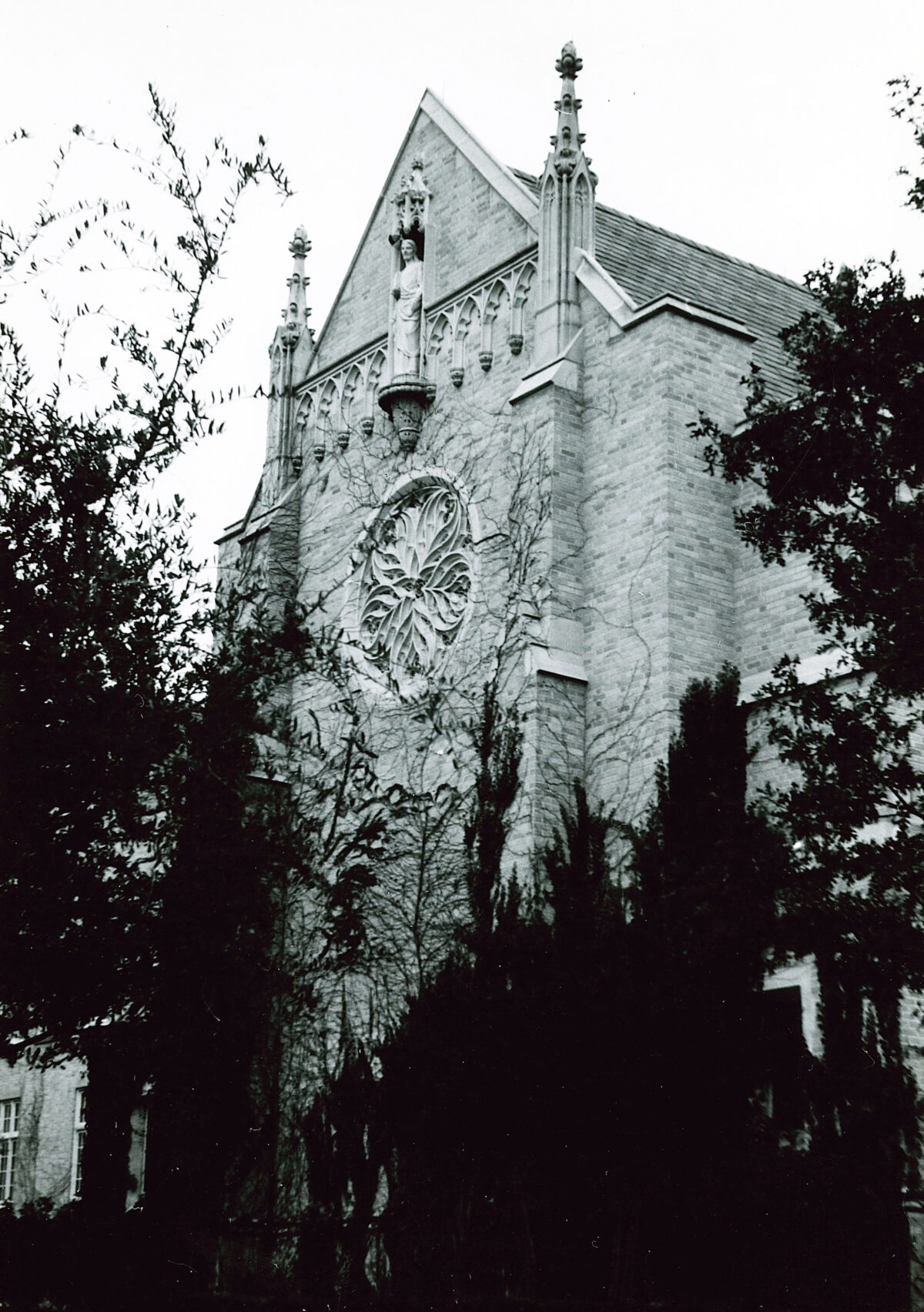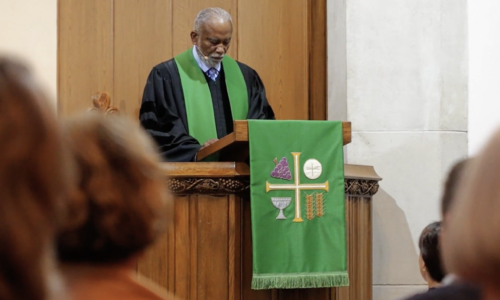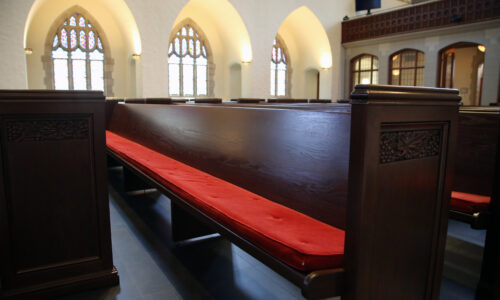Beautiful all the way around: The Cox Chapel story
September 13, 2022 by Analise Narine



When congregants joined Cox Chapel’s service online for the very first time during the unprecedented pandemic, the first thing in view during each virtual service was the chapel’s iconic Rose Window, made of stained glass in the shape of a rose, above the altar. Those who attended the first Cox Chapel service in 1951 likely could have never imagined being able to see the Rose Window—let alone watch an entire service—through a screen, but they would not be surprised by the traditions that are upheld by Cox Chapel today. That’s because many of them are the very same, just practiced over 70 years later. Let’s take a look at the historic Cox Chapel, then and now.
THEN: The Cox Memorial Chapel was given to the church by Mrs. Elizabeth Cox in memory of her parents, and was part of Highland Park United Methodist Church’s expansion from 1945 to 1951. The chapel was completed in 1951, with a seating capacity of 185 people.
NOW: The congregation, according to Stanton Nelson, Cox Chapel Coordinator & Accompanist, is why he does what he does. As this is his seventh year with Cox Chapel, Nelson has been able to get to know the congregation, which he describes as close-knit. Cox Chapel hosts socials, including a recent ice cream social with Kerygma and in past years, a Table of Thanks event for Thanksgiving.
THEN: Cox Chapel was designed in Gothic detail on both exterior and interior, with a figure of Christ crowning the west gable and a figure in prayer with hands clasped on the southwest corner of the chapel. The chapel was built with brick, trimmed with stone, and roughed with slate. The stained glass windows of the chapel allow light to stream through, conveying a sense of holiness.
The Rose Window, in particular, features symbolism through its geometric design, subdivided into meaningful elements—for example, the gold five-pointed star in the center representing the Star of Bethlehem as well as the Pentateuch (the Five Books of Moses). The Rose Window serves as a way to make the intangible aspects of Christianity, such as the Trinity, tangible to those who enter the chapel through geometry and color connotations.
NOW: “It’s a gorgeous chapel,” Nelson said. “The beauty, and of course the Rose Window, inspires everybody, along with the stained glass windows, the arches, and the organ loft right above the opening door.” The Rose Window has had significant prominence at the chapel, then and now. “During Cox Chapel’s COVID services, the prelude would begin and boom, there was the Rose Window,” he said. “It is the icon, I believe, of the chapel.”
Liturgy is a set of rituals included in religious worship. The literal definition of liturgy is the “work of the people.” Cox Chapel is about communal work and participation.
THEN: The first 11 am service began in April 1970, and served as an experiment in liturgy. A 9:30 am service was also added in 1980. Grady Hardin, Fred Kandeler, and Professor James experimented with reviving liturgical service in the Methodist church. Their work, placed in the Methodist Hymnal and Methodist Book of Worship, is the basis of liturgical worship today.
NOW: Cox Chapel places high emphasis on liturgical pieces and follows the Lectionary each week, the only service at HPUMC to do so. Cox Chapel also celebrates many days in the liturgical year, including Christ the King Sunday, Epiphany, Baptism of the Lord Sunday, Transfiguration Sunday, and Pentecost, with special music and liturgy.
THEN: The 11 am service that ran concurrently with Sanctuary responded to the needs of young people, especially those associated with the SMU campus. It began in April 1970 and was referred to as a ‘contemporary’ service. It was led by Dr. Grady Hardin, who was a professor of preaching at SMU’s Perkins School of Theology, and John Erickson, who was responsible for the music leadership.
NOW: Cox Chapel still has strong connections to SMU. Nelson said there are quite a few preachers from SMU, specifically from Perkins, on the preacher rotation. Along with his love for the liturgy of Cox Chapel, Nelson said his love for classical music, including that by composers Bach, Scarlatti, and Mozart, contributes to the fulfillment he feels as Cox Chapel Coordinator and Accompanist.
THEN: According to reports, the chapel was completely full at 8:30 am—the consistent service of Cox Chapel and the only service today—when it was led by Rev. Floyd Patterson, a member of the staff from 1970 to 2001. From the 1970s forward at Cox Chapel, there were a wide variety of preachers at the 8:30 am service.
NOW: Cox Chapel has allowed a great number of pastors to lend their gifts to the church throughout the years. Many of them were or would become bishops and senior pastors after leading Cox Chapel. This system of rotating pastors also allowed African-American and female pastors to preach at Cox Chapel, as they still do now.
Cox Chapel is truly unique, with its own set of Communion responses, its own liturgy for Communion, a tradition of Passing the Peace in the service, Prayer of Confession and Words of Assurance, and multiple Scripture readings.
Holiday events that bring the community together are also hosted by Cox Chapel. At the Easter vigil services, for example, the Christ Candle is carried from the colonnade in the garden into a completely dark chapel. Then, the light slowly comes back on during the Gospel Reading. The Christmas candlelight service features an alternation of hymns and scripture readings.
For someone who hasn’t been to a service at Cox Chapel, words like “liturgy” or “ritual” may sound intimidating. However, many of the traditions go back to the very early church, making them truly historic. Some of the creeds recited by Cox Chapel were written in the fourth century.
“It's an elegant service,” Nelson said. “It is beautiful all the way around, from the music to the scenery, and coming up to the Communion rails every Sunday. I find it all very lovely.”
Cox Chapel is a building steeped in history, with a service and a congregation that is truly set apart. The traditions of the chapel allow a glimpse into the worship of centuries ago, with a beautiful setting that continues to inspire.




